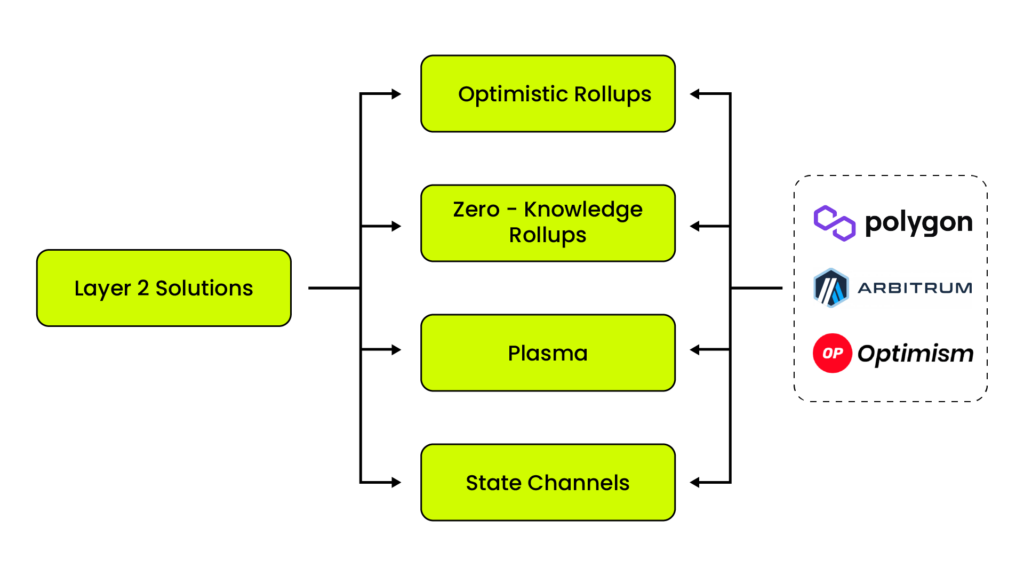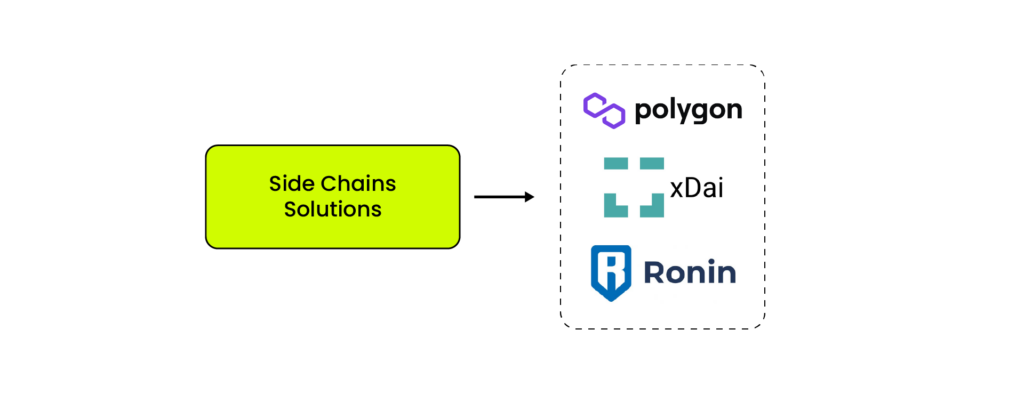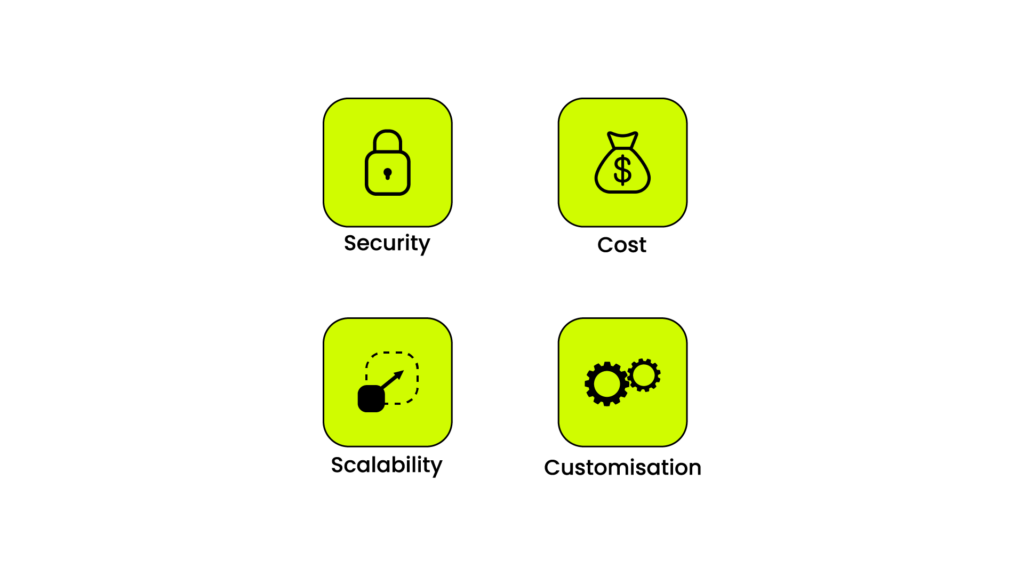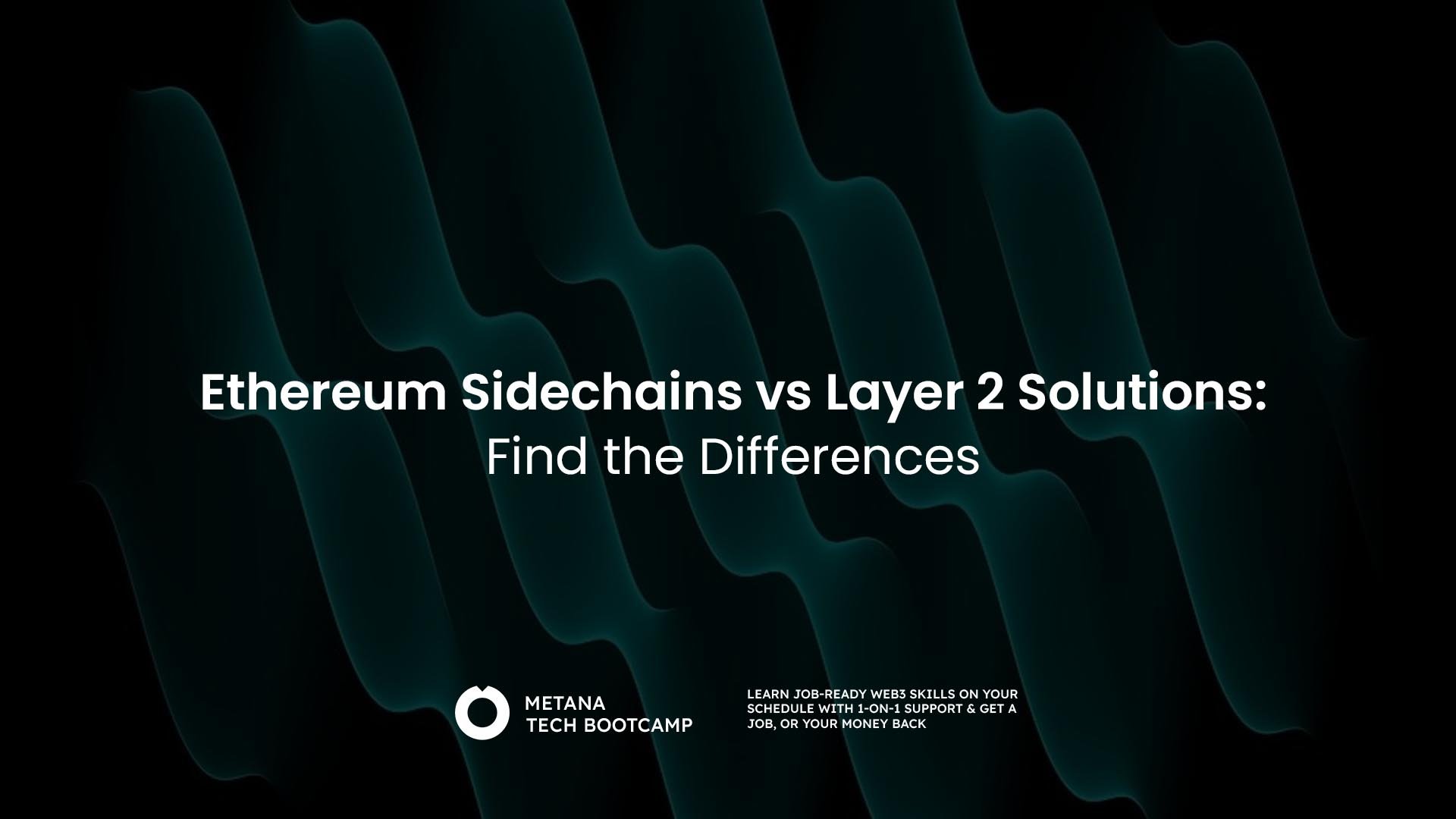Ethereum has revolutionized the blockchain industry by creating dApps, DeFi, and NFTs. Despite these advancements, scalability issues have led to congestion, high gas fees, and slower transaction times. The community is exploring sidechains and Layer 2 technologies to tackle these challenges. Understanding the differences between sidechains vs Layer 2 solutions is essential to deciding which technology best fits specific projects.
What are Layer 2 Solutions?
Layer 2 solutions refer to a set of technologies built on top of the Ethereum mainnet that aims to improve scalability by offloading transactions from the main blockchain. These solutions maintain a close relationship with the Ethereum network, leveraging its security while providing faster and cheaper transactions. Layer 2 solutions are essential for scaling Ethereum without compromising its core principles of decentralisation and security.
Different Types of Layer 2 Technologies

Layer 2 solutions encompass a variety of technologies, each with its unique approach to scaling. The most notable types include,
- Optimistic Rollups: This type involves bundling multiple transactions into a single batch then recorded on the Ethereum mainnet. Transactions are assumed to be valid by default, with only challenges if fraud is suspected.
- Zk-Rollups: Similar to Optimistic Rollups, zk-Rollups also batch transactions. However, they use zero-knowledge proofs to verify the correctness of transactions, providing higher security and faster finality.
- Plasma: A framework that allows the creation of child chains (smaller blockchains) anchored to the Ethereum mainnet. Plasma chains handle a high volume of transactions while periodically submitting a summary to the mainnet for security purposes.
- State Channels: State channels enable participants to conduct multiple transactions off-chain, with only the final state recorded on Ethereum. This reduces the number of on-chain transactions, thus lowering fees and increasing speed.
Each technology addresses Ethereum’s scalability differently, offering trade-offs between security, speed, and complexity.
Notable Layer 2 Projects on Ethereum
Several projects have successfully implemented Layer 2 solutions to enhance Ethereum’s performance. For example:
- Arbitrum: An Optimistic Rollup solution that has gained significant traction for reducing gas fees while drastically maintaining high security.
- Optimism: Another Optimistic Rollup project, Optimism, focuses on providing an easy-to-use solution for developers and has attracted significant dApps in the Ethereum ecosystem.
- Polygon (as a hybrid): This functions as a sidechain and provides Layer 2 solutions, such as its PoS (Proof-of-Stake) chain, enabling fast and cost-effective transactions.
These projects have played a pivotal role in demonstrating the potential of Layer 2 technologies to scale Ethereum without sacrificing decentralisation.
Advantages of Layer 2 Scaling
The primary advantages of Layer 2 scaling include,
- Lower Transaction Fees: By processing transactions off-chain or in batches, Layer 2 solutions significantly reduce the cost per transaction, making Ethereum more accessible to users.
- Faster Transactions: Transactions on Layer 2 networks are confirmed more rapidly than on the Ethereum mainnet, significantly improving the user experience, particularly for applications requiring swift confirmations.
- Enhanced Scalability: Layer 2 technologies increase Ethereum’s capacity to handle more transactions per second, essential for supporting the growing ecosystem of dApps and DeFi projects.
What is Sidechain?
Sidechains are independent blockchains that run alongside the Ethereum mainnet. They are linked to Ethereum through a two-way peg, which allows assets to move between the mainnet and the sidechain. Although sidechains can provide scalability benefits similar to Layer 2 solutions, they operate under a distinct security model and have greater autonomy. This enables them to have custom rules, consensus mechanisms, and fee structures.
How Sidechains Operate
Sidechains operate independently of the Ethereum mainnet, which means they have their consensus mechanisms, validators, and security protocols. This autonomy allows sidechains to implement different features and optimisations that might not be feasible on the mainnet. However, this independence also means that sidechains do not inherit the security of Ethereum’s mainnet and must rely on their security measures.
Popular Ethereum Sidechain Projects
Some of the most well-known Ethereum sidechain projects include:
- Polygon (as a sidechain): While offering Layer 2 solutions, Polygon’s PoS chain functions with its validators and consensus mechanism, providing fast and low-cost transactions.
- xDai: A stablecoin-focused sidechain that offers low fees and fast transactions, making it ideal for everyday payments and microtransactions.
- Ronin: This represents a sidechain tailored for the Axie Infinity game, showcasing the adaptability of sidechains for specific applications.

These sidechains have gained popularity due to their ability to offer customised solutions for various use cases while benefiting from Ethereum’s broader ecosystem.
Benefits of Using Sidechains
Sidechains offer several benefits, including,
- Customizability: Developers can implement different consensus mechanisms, governance models, and fee structures tailored to their project’s needs.
- Scalability: Like Layer 2 solutions, sidechains can process a high volume of transactions at lower costs, making them suitable for applications with significant user activity.
- Experimentation: Sidechains provide a sandbox environment for experimenting with new technologies and features that might be risky or incompatible with the Ethereum mainnet.
Sidechains vs Layer 2s
Security Models Compared
One of the most significant differences between sidechains and Layer 2 solutions is their security model. Layer 2 solutions, such as Rollups, rely on Ethereum’s security, meaning that they benefit from the robustness of the Ethereum mainnet. In contrast, sidechains operate independently, with their security depending on their validators and consensus mechanisms. This difference makes Layer 2 solutions generally more secure than sidechains, though sidechains offer more flexibility.
Transaction Finality and Confirmation Times
Layer 2 solutions often provide faster transaction finality compared to sidechains. For example, transactions on Rollups are confirmed more quickly because they are processed in batches on the Ethereum mainnet. Sidechains, however, may have longer confirmation times, depending on their consensus mechanism and the speed of their validators.
Interoperability with Ethereum Mainnet
Layer 2 solutions are closely integrated with the Ethereum mainnet, allowing for seamless interaction between Layer 2 and the mainnet. This integration ensures that assets and data can move quickly between the two layers. While interoperable with Ethereum, sidechains typically require bridges or other mechanisms to transfer assets, adding complexity to the process.
Data Availability and Storage
Data availability is another area where Layer 2 solutions and sidechains differ. Layer 2 solutions generally store data on-chain, ensuring it is available and secure. Sidechains, however, may store data off-chain, which can lead to challenges in providing data availability and integrity, especially if the sidechain becomes compromised.
Choosing Between Sidechains and Layer 2 Solutions
Sidechains are great for customised projects like enterprise solutions, specialised dApps, and applications needing a consensus mechanism different from Ethereum’s. They are also suitable for handling large transaction volumes independently from Ethereum’s mainnet.
Layer 2 solutions are ideal for applications that require high throughput, low latency, and close integration with Ethereum. Examples include decentralised exchanges (DEXs), gaming platforms, and financial applications.
Making the Right Choice for Your Project
When deciding between Layer 2 solutions and sidechains, you should consider the following factors:
- Security: How vital is Ethereum’s mainnet in protecting your project?
- Cost: What are the cost implications of using a Layer 2 solution versus a sidechain?
- Scalability: Does your project demand high throughput and low latency?
- Customization: Do you require the flexibility to implement custom features or consensus mechanisms?

Evaluating Security Trade-Offs
Layer 2 solutions generally offer higher security due to their reliance on Ethereum’s mainnet. However, a sidechain may be more appropriate if your project requires a different security model or greater control.
Assessing Scalability Requirements
Consider the scalability needs of your project. Layer 2 solutions may be the best option if you require high throughput and low costs. A sidechain could be more suitable if you need to handle a large volume of transactions independently.
Cost Implications and Economic Models
Layer 2 solutions typically offer lower transaction costs than the Ethereum mainnet, but sidechains can provide even lower fees, especially for high-volume projects. Consider the economic model of your project and how transaction fees will impact your users.
Developer Ecosystem and Tooling Support
Layer 2 solutions have extensive support from the Ethereum developer community, with a wide range of tools and libraries available. Sidechains, while offering more flexibility, may require more specialised development resources.
Future Potential and Emerging Trends
As Ethereum continues evolving, both Layer 2 solutions and sidechains will play critical roles in scalability. Emerging trends include the development of Layer 3 solutions, which aim to build even more scalable and efficient infrastructures on top of existing Layer 2 technologies. Additionally, hybrid models that combine the benefits of both Layer 2 and sidechains are being explored, offering new possibilities for developers and users.
Conclusion
Ethereum’s scalability challenges have resulted in the emergence of Layer 2 solutions and sidechains, each with distinct advantages and trade-offs. Layer 2 solutions offer robust security and seamless integration with Ethereum, while sidechains provide greater flexibility and customisation. The selection of these technologies should be based on the particular requirements of your project, taking into account aspects such as security, scalability, cost, and developer support. As Ethereum progresses, Layer 2 solutions and sidechains will significantly impact its trajectory.
FAQs
What is the primary difference between Layer 2s and sidechains?
- The primary difference lies in their security models. Layer 2 solutions leverage Ethereum’s security, while sidechains operate independently with their security protocols.
How do Layer 2 solutions improve Ethereum’s scalability?
- Layer 2 solutions offload transactions from the Ethereum mainnet, reducing congestion, lowering fees, and increasing transaction throughput.
Are sidechains as secure as Layer 2 solutions?
- No, sidechains do not inherit Ethereum’s security and rely on their validators and consensus mechanisms, making them potentially less secure.
When should a project choose a sidechain over a Layer 2 solution?
- A project should choose a sidechain if it requires high customizability, such as different consensus mechanisms or specialised applications that operate independently of Ethereum’s mainnet.
What are the cost implications of using Layer 2s vs. sidechains?
- Layer 2 solutions typically offer lower transaction costs than the Ethereum mainnet; sidechains can even lower fees, especially for high-volume projects.








